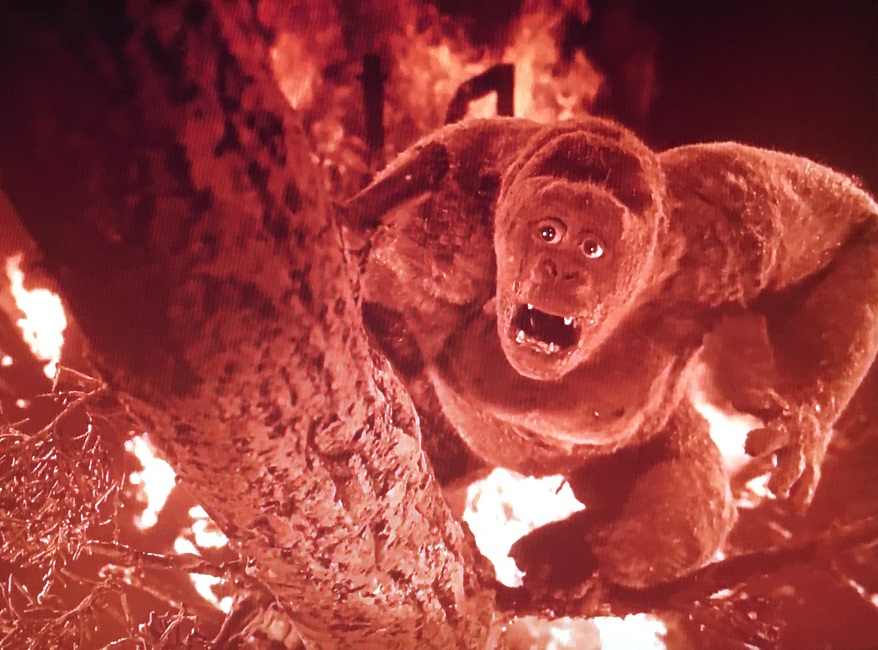



Destination Moon – 1950 (WINNER)
 I really liked this movie because there were so many things they got right. Not everything was perfect, but they were trying, with their 1950 knowledge of space travel. This movie was unique in that it was trying to be as factual as possible, going a little bit into the science of their fiction, whereas other sci-fi movies were just basing their plots on uneducated guesses, or more often than not, pure fantasy.
I really liked this movie because there were so many things they got right. Not everything was perfect, but they were trying, with their 1950 knowledge of space travel. This movie was unique in that it was trying to be as factual as possible, going a little bit into the science of their fiction, whereas other sci-fi movies were just basing their plots on uneducated guesses, or more often than not, pure fantasy.
The was only one thing that didn’t really work for me, so I’ll get that out of the way, right off the bat. As the four men blast off from the surface of the earth, they are immediately hit with g-forces so strong, the skin on their faces pulled back in an almost comical way. This was accomplished using invisible pieces of tape that actually stretched the skin of their faces. The astronauts were screaming in pain and could barely even move their arms.
You see, to me, that seemed like the silliest effect in the film. So I did my research. But I discovered that it was I who was wrong, and not the film. Modern Astronaut John Grunsfeld described the act of taking off as an actually painful process that lasts about eight and a half minutes. He said it makes you feel as though you weigh seven hundred pounds. So, score one more for the movie, though the actors with their stretched faces did look a little silly.
Another thing about the movie that I learned which surprised me concerned the few wide shots of the rocket ship as it was being built. I just assumed that it was either a matte painting or a scale model. But again, I was wrong. While those techniques were used at various times, they actually built a life-sized structure for several shots. Once again, I am impressed.
To create the illusion of the astronauts floating weightless in space, invisible wires were used, and several times, a simple effect of turning a camera on its side made it appear as if an actor was walking down a wall. But the illusions were complete. I couldn’t see the wires, though at times there were up to thirty-six strands holding up each of them. There were shots during a sequence when the four men are walking on the outside of the spaceship, in which they are not only floating, but turning at strange angles.
And finally, the moon itself was a pretty cool bit of artistry. Apparently, the matte-painter, Chelsey Bonestell, was a professional sci-fi artist, and the crew who constructed the sets were given actual photos of the moon to work with. The result was a fantastic moonscape that looked as realistic as they could make it. The movie was really an impressive bit of filmmaking, considering all the attention to detail concerning something that had never actually been done. Very cool!




 The Special Effects for this nominee come down to one thing: the big climactic scene in which there is a massive oil drilling fire. That was basically it for the entire film. The movie was like the previous 1940 Best Special Effects nominee, Boom Town. The only difference, really, was that the earlier film was in black and white, and this movie was in glorious Technicolor.
The Special Effects for this nominee come down to one thing: the big climactic scene in which there is a massive oil drilling fire. That was basically it for the entire film. The movie was like the previous 1940 Best Special Effects nominee, Boom Town. The only difference, really, was that the earlier film was in black and white, and this movie was in glorious Technicolor.











 OK, am I being punked? What is going on here? This movie was one of only two that were nominated for Best Special Effects in 1948. Am I to believe that there was only one other movie that year with visual or sound effects as good as this one? The visual effects came down to a single scene! A single five minute scene! Other than a small handful of standard rear-projection shots, there was nothing!
OK, am I being punked? What is going on here? This movie was one of only two that were nominated for Best Special Effects in 1948. Am I to believe that there was only one other movie that year with visual or sound effects as good as this one? The visual effects came down to a single scene! A single five minute scene! Other than a small handful of standard rear-projection shots, there was nothing!



 I found this to be, I’m sorry to say, a pretty dull movie. It was slow and predictable, and when it came to the special effects, I honestly wasn’t very impressed. By this time, Hollywood had been giving us better special effects for some time, and while a few of the effects were interesting, some even well-done, most of them were just average in quality.
I found this to be, I’m sorry to say, a pretty dull movie. It was slow and predictable, and when it came to the special effects, I honestly wasn’t very impressed. By this time, Hollywood had been giving us better special effects for some time, and while a few of the effects were interesting, some even well-done, most of them were just average in quality.














